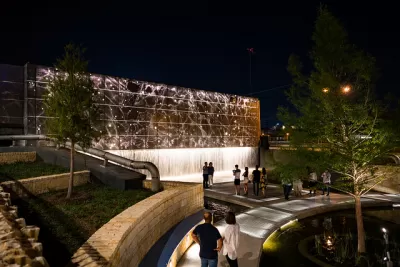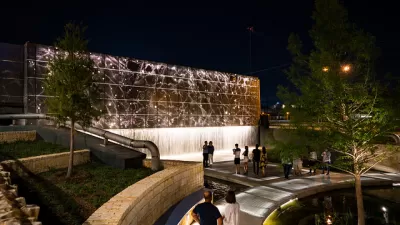The new San Pedro Creek Culture Park is being touted as a celebration of Latinx culture.

"The first part of phase 1 of the San Pedro Creek redevelopment in San Antonio, Texas, is now open to the public, and the waterway’s rejuvenation has been touted as a celebration of Latino culture in the city," according to an article by Jonathan Hilburg.
San Pedro Creek was formerly not much more than concrete drainage ditch. With Phase 1 complete, a 2,200-foot-long stretch of the creek has been dubbed the San Pedro Creek Culture Park. The new park is only the first phase in an eventual restoration of 2.2 miles of the creek through San Antonio.
"The opening of the first phase on May 5 coincided with the 300th anniversary of San Antonio and was commemorated by the unveiling of Rain from the Heavens, a public art installation cut on stainless steel panels depicting what the stars looked like that night in 1718," adds Hilburg.
The article includes more details about the planning and design decisions made by San Antonio-based designer Muñoz and Company. The second phase pf the project is expected to be complete by 2020.
Flyover of San Pedro Creek from Architect's Newspaper on Vimeo.
FULL STORY: San Antonio’s “Latino High Line” opens to the public

Trump Administration Could Effectively End Housing Voucher Program
Federal officials are eyeing major cuts to the Section 8 program that helps millions of low-income households pay rent.

Planetizen Federal Action Tracker
A weekly monitor of how Trump’s orders and actions are impacting planners and planning in America.

Ken Jennings Launches Transit Web Series
The Jeopardy champ wants you to ride public transit.

Rebuilding Smarter: How LA County Is Guiding Fire-Ravaged Communities Toward Resilience
Los Angeles County is leading a coordinated effort to help fire-impacted communities rebuild with resilience by providing recovery resources, promoting fire-wise design, and aligning reconstruction with broader sustainability and climate goals.

When Borders Blur: Regional Collaboration in Action
As regional challenges outgrow city boundaries, “When Borders Blur” explores how cross-jurisdictional collaboration can drive smarter, more resilient urban planning, sharing real-world lessons from thriving partnerships across North America.

Philadelphia Is Expanding its Network of Roundabouts
Roundabouts are widely shown to decrease traffic speed, reduce congestion, and improve efficiency.
Urban Design for Planners 1: Software Tools
This six-course series explores essential urban design concepts using open source software and equips planners with the tools they need to participate fully in the urban design process.
Planning for Universal Design
Learn the tools for implementing Universal Design in planning regulations.
Ada County Highway District
Clanton & Associates, Inc.
Jessamine County Fiscal Court
Institute for Housing and Urban Development Studies (IHS)
City of Grandview
Harvard GSD Executive Education
Toledo-Lucas County Plan Commissions
Salt Lake City
NYU Wagner Graduate School of Public Service





























